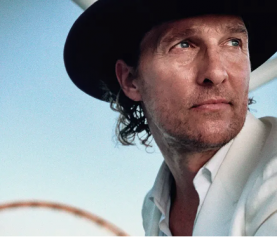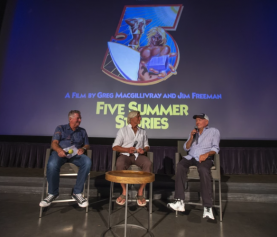MFF president Shaun MacGillivray looks at how he’s expanding the company’s business model, how the coronavirus pandemic impacted the company, and why he’s excited about the future.
The year 2020 was extremely challenging for many industries, including the movie business. How has MFF been faring, and did you make any changes to your business model as a result?
There is no doubt it has been a tough year, especially for the distribution side of our business. We went from having 35 different films playing in 300 markets around the world to zero films in zero markets. But while movie theaters, film studios and distributors were especially hard hit, the flip side is that business for streaming content has exploded. Everyone stuck at home needed new entertainment. And so early on, even before the pandemic hit, we were looking to expand the kind of content we produce to include streaming content. The pandemic just accelerated it. Many of our library films are now available to stream, and we have started producing original content for third-party streaming providers as well. So even though our theatrical distribution business ground to a halt, our production team definitely stayed busy, and we’re positioned well for growth as we come out of this.
What are some of the new projects you’re working on?
We are fortunate to be working with some great partners on a number of projects. I’m really excited about a docu-series we just completed called Out Where The West Begins based on the book by Phil Anschutz. It’s about the innovators and entrepreneurs who developed and lay the groundwork for building the American West. We have also been working with a number of tourism boards like Discover Charleston and Discover Anaheim on some custom short-form content, and we’re working with a Native American tribe on a docu-series about their history. To name a few.

The MFF film crew filming the docu-series ‘Out Where the West Begins’.

A scene from ‘Playgrounds’, a short-form video series produced for GoUSA TV, featuring the famous Iowa baseball field seen in the Hollywood film ‘Field of Dreams’.
You’ve also just finished work on two 4D flying films.
Yes, those are pretty exciting. We’re working with SimEx-Iwerks to produce custom films for their new 4D “flying theatres,” which give people the sensation that they’re flying. Kind of like the “Soaring Over California” ride at Disneyland. We just finished the films for two theatres, one for FlyRide Branson and the other for the Wilderness Resort in Wisconsin Dells. We definitely had to learn some new tricks to produce films for 4D theaters, but it’s been a lot of fun.
Have you had to make any production adjustments as you’ve transitioned into these new forms of content?
Our company was built on producing high-quality visual storytelling, and while we’re most known for our award-winning IMAX films like Everest and National Parks Adventure, what sets us apart is our ability and track record of producing films in a highly creative, highly visual way. That ability transcends all screen sizes and all platforms. Every partner we have worked with has been overjoyed with the end-product, whether a 40-minute giant screen documentary or a 15-second spot. Which is why we continue to get repeat business from our clients. The wave of the future for marketing and content production is going to continue to move towards longer form, authentic storytelling and that’s where we shine. We are experts at creating stories that are highly visual as well as emotional and inspiring.

A scene from ‘Under One Sky’ produced for the National Cowboy and Western Heritage Museum.
Given your expansion into new forms of content production, will IMAX films continue to be an important part of your business model?
The IMAX theatres are an incredibly important part of our business and will continue to be. In the early part of the year, we released our new film Into America’s Wild, narrated by Morgan Freeman, which had a limited release due to COVID, but which we’ll ramp up again for a re-launch in 2021. We have been working hard to finish Ireland for next March, and we also have a director’s cut of Everest coming out in the spring as well. So, in no way are we taking our focus off our partnerships with these amazing giant screen theatres. We are simply expanding our client base to include streaming platforms, TV broadcast partners, social agencies, you name it. We are visual storytellers. We can create content for iPhones and IMAX theatres.

Director Greg MacGillivray directs Irish teens for a surf scene in the company’s upcoming film ‘Ireland’.
Tell us about the new scanner you recently purchased for the upcoming digital release of Everest.
This is the scanner we have been waiting for. It’s the new Lunr scanner, previously known as the Golden Eye by Digital Vision, and it uses new technology and the most up-to-date sensors to scan 65mm 15 perf film at up to 22k x 16k resolution, making it the highest resolution scanning solution currently available. It has a better look, a better resolution, it is more reliable and it is the fastest scanner there is. We decided it was important for us to own it primarily because we have the largest 15/70 mm film footage library in the world. We want to scan our most iconic, important shots and also those films of ours that haven’t been released digitally yet, like Everest. We also plan to offer scanning services to those directors, cinematographers and producers who are still excited about shooting in film like we are, and who need a digital conversion solution that is state of the art. Talking to partners like Kodak, it is apparent that retro is still really cool. There are a lot of filmmakers using 8mm and 16mm because they love the look and the magic that only film can offer. And while I don’t see the scanning business as a growth industry, using film as a capture medium will continue to be relevant and important, and the best way to digitize that film is with our scanner. We have already started working with outside producers and directors and I think it is something we’ll continue to expand.

The MFF team on location in Glacier National Park.
Any other outside-the-box projects in the works?
We’re in the beta testing phase of our own MFF-hosted streaming platform called Movies for Families that would give us the ability to offer easy access to our films and educational resources for our fans and for families and educators. All with the understanding that our most important partners are our theatrical exhibition partners, the museums and science centers that show our films, so we would make sure they felt comfortable with it and could see the benefit of it as well. We have also launched a weekly newsletter with a round-up of inspiring things that excite us, like films, podcasts, books, articles. I think it is so important for us to foster a community and to have this mindset of “never stop learning.” We love having this new connection to our fans and followers, and the feedback has been phenomenal.
What is your forecast for 2021? Are you a glass-half-empty or glass-half-full person?
I’m definitely a “glass-more-than-half-full” person and I’m incredibly excited for 2021. As these vaccines get distributed all over the world, you’re going to see an incredible recovery in industries globally, and you’ll see the importance of storytelling for these industries to be able to inspire, to educate, to share their values, and to get people excited in a new way. Over the last six months we have been doing a lot of development on projects that have the potential to hit at just the right moment, and I think our production team will probably be busier than ever before. On the distribution side, about 40 to 50% of our theatre clients have re-opened with reduced seating capacity, so things are slowly ramping back up. I am incredibly bullish about people returning to theatres and wanting to have that shared experience outside of the home. If I say to my wife, “Hey, let’s have a date night,” I want to get off the couch and go catch a movie and have that sense of shared community again.






